Piping in the bathroom: analysis of hidden and open piping layouts
Are you planning to renovate your bathroom with a complete replacement of water pipes? Establishing communications usually takes a lot of time and money.Agree, it will be a shame if, soon after repair, one of the pipes leaks or a more serious breakdown occurs. To prevent this from happening, you should not only have an idea, but also know the basic principles of pipe routing in the bathroom.
Many, even novice home craftsmen, are ready to do plumbing work on their own. And this is quite realistic - pipe routing in a bathroom or combined bathroom can be done independently, since new technologies and materials greatly simplify the installation and maintenance of engineering systems.
In this article we will talk about the principles of piping in the bathroom. We will explain the differences between hidden and open installation systems, and tell you how to independently arrange a utility network. We will present thematic photographs, diagrams and videos that will help to better understand the essence of the issue.
The content of the article:
How to start?
You should not follow the example of those who prefer to do everything “by eye”. You should start with a future wiring project. This may seem unnecessary and even too complicated, but, nevertheless, such a project is necessary.
With its help, you can accurately determine the optimal location for each plumbing fixture, select the necessary parts and pipeline elements, and determine their flow rate.
It is recommended to start the project with a list of plumbing equipment that is planned to be placed in the bathroom. It is important to know that if the toilet and bathroom are separated in the house, you need to carry out a wiring project for both rooms. This is explained by the fact that their communications are connected and cannot be mounted separately.
Having decided on the list of plumbing fixtures, you should mark which pipes need to be connected to each of the devices.
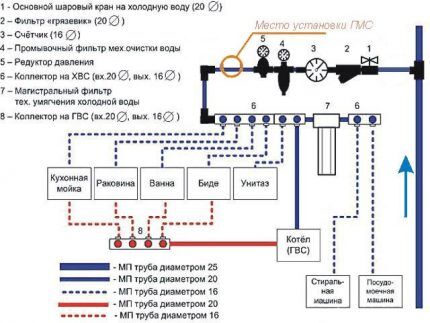
You can focus on this diagram:
- Any type of bath or shower. Cold and hot water supply is connected, as well as sewerage.
- Washbasin. Sewage, hot and cold water supply are provided.
- Bidet. Connects to hot and cold water supply pipelines and sewerage.
- Toilet. Cold water and sewer lines are connected.
- Washing machine. Sewage and cold water supply are provided.
At the next stage, you need to build a diagram that will form the basis of the future project. To do this, precise measurements of the room are taken, based on which a diagram is subsequently constructed. It is advisable to do it on graph paper at a suitable scale.
All dimensions must be strictly observed. This is an important condition for completing a competent project. All plumbing fixtures are measured in the same way. Their dimensions are needed in order to “fit” the equipment into the room as accurately as possible.
If you have not yet made a final decision regarding the location of the plumbing, you can proceed as follows.On paper, exactly according to the measurements taken and in accordance with the scale of the room, a schematic representation of each plumbing fixture is built.
The pattern is cut out, and the resulting figures are placed on the floor, achieving the optimal arrangement of devices.
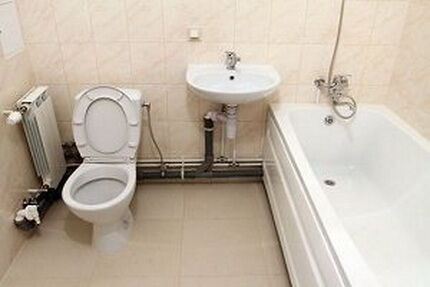
In this case, the following requirements must be taken into account. The first from the sewer riser is traditionally toilet being installed. It is optimal that its outlet is connected to the riser through a fitting. A large distance from the riser, and even more so the presence of turns in the pipeline, will provoke blockages and will not allow the equipment to operate normally.
It is advisable to place plumbing fixtures in such a way that the drainage from them flows through the toilet. This will be a very good prevention of blockages.
In addition to the toilet, it is recommended to place a bathtub or shower with a low drain as close to the sewer riser. This is necessary to prevent possible slope problems. The rest of the plumbing equipment can be placed at any convenient distance.
In addition, it is advisable to carefully study the technical documentation for plumbing equipment for its connection. If a standard option is assumed, which provides for a single-level arrangement of the pipeline and the axis of the sewer outlet of the device, no problems will arise.
If a non-standard connection is assumed, you should prepare for all its features.
Most often, toilets may have variations in connection.Depending on the model, their drain can be straight or inclined, and also directed towards the floor or wall. Installation technology toilet with oblique outlet has its own characteristics.
May be atypical connection of shower cabins and baths. Their drainage junctions may have different configurations. All these features must be taken into account at the design stage.
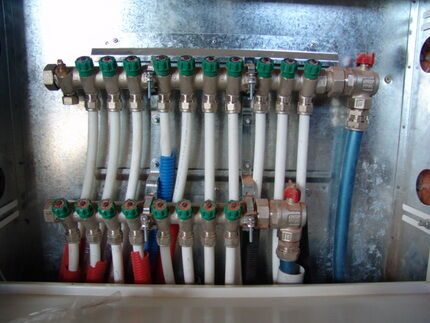
After the installation locations of the plumbing fixtures are fixed, work begins with the placement of pipelines suitable for them. The scale of the diagram must be strictly observed; this is the only way to correctly install the pipes in the bathroom.
An important nuance. When “arranging” plumbing fixtures and furniture, you should not forget that all doors in the room should open freely and each device should be easy to use.
Types of utility wiring
Before designing the wiring, you should become familiar with what types of such structures exist. There are only three of them. Moreover, one, with pass-through sockets, is practically not used. Therefore, we will not consider it.
Type #1. Serial type wiring
To implement this, taps are made from the cold and hot water supply risers leading to the first consumer. Pipes are laid from it to the second and further. Each water collection point is equipped with a tee, to one of the outlets of which the consumer is connected.
Overall this is a very simple scheme. It can only be used where the number of water consumers is small.
This is due to the fact that if several water collection points are activated simultaneously, the pressure in them will weaken and may be insufficient for the correct operation of the equipment. This is the main disadvantage of series wiring.
However, for apartments with one bathroom and a small amount of plumbing used, this may be the best option. A significant drawback of the system is the inability to turn off one of the plumbing fixtures for replacement or repair.

There are many more advantages to sequential wiring. First of all, it is simplicity in design and installation. There will be no complex schemes here, everything is done very simply.
In addition, such wiring is considered the most economical option.The consumption of pipes and other elements will be significantly lower than in other systems, and installation costs are also minimal.

Type #2. Collector type of wiring
The collector type scheme involves connecting each of the consumers to the main line. For this, a special element is used, which is called a collector - a device that distributes water flows.
In a more complex version, and this is best, each collector outlet is equipped with a shut-off valve. Collector-type wiring can be considered the most convenient option to use. There are several reasons for this.
Firstly, no pressure drops in the system.All consumers receive equally good water pressure, even if all water points operate simultaneously.
If pressure in the apartment system or private house or for some reason too little, you can temporarily limit the water supply to one of the consumers, for example, to the toilet, thereby increasing the pressure for others.

Secondly, the ability to disconnect plumbing fixtures from the water supply if they need replacement or repair.
Third, reliability. In fact, a single pipe goes to each consumer, without any connections or other elements. A leak can only appear in the collector area or near the device itself. Here it will be very easy to find. For this reason, pipes with manifold wiring can be safely installed using a hidden method.
Fourth, ease of use. If there is a problem with a plumbing fixture and a leak appears, for example, at a faucet, you do not need to crawl under the sink. It is enough to close the shut-off valve on the manifold leading to the faulty device and wait for the specialists to arrive.
Even a woman or child unfamiliar with plumbing can do this. At the same time, all other equipment will work properly.
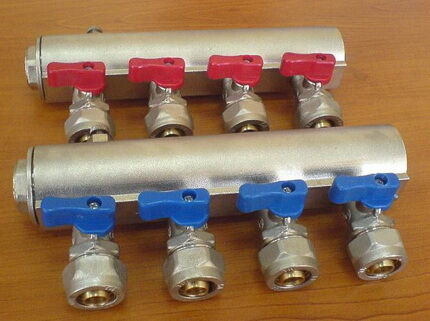
However, collector wiring also has some disadvantages. First of all, it will cost the owner more than a sequential circuit. This is due to the fact that it will be necessary to lay a branch to each consumer. This will take a lot more material.
In addition, the installation of manifolds and shut-off valves will be required if the distributors are not equipped with them. And the circuit itself will be much more complicated than a sequential one.
Methods for installing water pipes
To install plumbing pipes, you can choose one of two options: hidden and open. Let's look at the latter in more detail.
Method #1. Open gasket
Open installation assumes that pipes and other utility elements are mounted directly on the wall or above the floor. This makes their installation extremely easy and cheap. But the overall appearance of the bathroom suffers from this.
The advantages of open installation include:
- possibility of continuous monitoring over the state of utilities - pipes are always visible and the appearance of a leak will not go unnoticed;
- ease of installation - the parts are connected and fixed in place, even a novice plumber can handle the job, taking into account, of course, the way the elements are connected.
- availability — installation cost is minimal.
Disadvantages include the possibility of mechanical damage to open pipes. But this is more likely to be true for plastic parts. Steel pipes are not that easy to damage.
In addition, engineering communications are available for everyone to see, which, of course, is ugly. This disadvantage can be combated.When carrying out a wiring project, you should try to choose a place for laying pipes so that they are as inconspicuous as possible.

It is clear that it will not be possible to completely disguise them in this way. Therefore, home craftsmen use all kinds of designs to hide unsightly pipes. The easiest way is to cover them in a box.
Most often it is made of plastic panels or plasterboard. The latter must be moisture resistant, given that it will be used in the bathroom.
If space allows, it is quite possible to use false walls behind which pipes are laid. A good option is roller shutters; they look especially good behind the toilet.
When choosing an option for masking communications, you need to understand that aesthetics should not interfere with functionality, therefore all masking structures must be equipped with hatches through which inspection and necessary repairs of pipes will be carried out.
In addition, some pipes are not recommended to be masked. These are, for example, parts made of steel. They are susceptible to corrosion, which develops especially quickly in conditions of high humidity. Therefore, they are best used only in open form.
The maximum is to close it with an easily removable box and regularly carry out inspections for the appearance of external corrosion, which must be dealt with immediately.
Method #2. Hidden installation of utilities
Laying out pipes in a hidden bathroom involves installing parts inside specially provided or newly created voids in building structures. These can be small niches or grooves hollowed out in the walls, whose dimensions are slightly larger than the diameter of the pipes being laid.
Hidden laying also includes laying the pipeline in a screed, when a layer of concrete mortar is mounted on top of the parts.

The undoubted advantage of this option is aesthetics. Engineering connections and communications are completely invisible. Pipeline outlets in the form of sewer sockets or water outlets are placed on the walls or in the floor. Accidental damage to pipes is impossible.
Significant disadvantages of the method include:
- labor intensity;
- cost;
- lack of ability to control the condition of the pipeline.
Let's take a closer look at hidden installation. First of all, it is not always possible. Cutting or hollowing out grooves in walls is allowed in private houses built from solid blocks or bricks, as well as in open-plan apartments.
In the latter, walls of increased thickness are made. In all other cases, there may be conflicts with building codes.
Load-bearing structures experience significant load. The grooves significantly weaken them. This is acceptable for walls of increased thickness. For standard ones, which are most often used in standard buildings, no.
Making grooves in floor slabs is strictly prohibited for all types of buildings.As an alternative to grooves, the pipeline can be laid behind the wall sheathing, in the screed or in the above-ceiling space, if necessary.
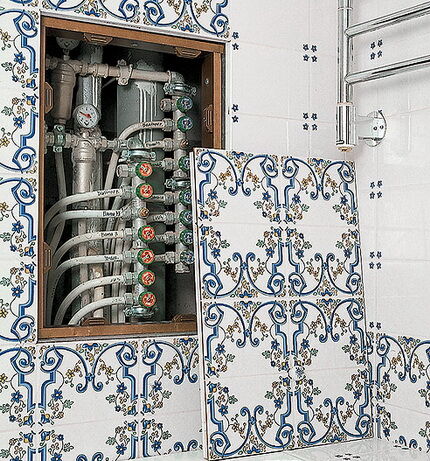
Difficulties may arise with the sewer pipeline if it needs to be disguised under the floor. This happens when, for example, you need to connect communications to an island bathtub located in the middle of the room or at a considerable distance from the wall. Sewer pipes have a large diameter, so they cannot be laid in a screed.
In this case, it will turn out to be too high and heavy, which will become too much of a load on the floors, which may simply not withstand it. The best solution is to build a small podium, under which there will be enough space for utilities. The design can be frame or block.
Regardless of the location where the pipeline is hidden and its purpose, the method of installing the parts does not change. All elements of the pipeline are laid in a special casing pipe, the latter is placed in a prepared technological cavity.
After the pipeline is laid, the cavities are sealed and the base plane is leveled. If necessary, a topcoat is applied.
The main disadvantage of hidden installation is the inability to control the condition of the pipeline. For this reason, all its elements must be as resistant to corrosion as possible and reliably connected. Proper installation is very important.
The best option for hidden installation are plastic, copper and metal-plastic pipes.

Another important point that must be taken into account when installing pipes hidden is to prevent possible condensation formation. If this happens, moisture will appear inside the structure, which will sooner or later cause its destruction.
Therefore, it is recommended to place the hot water pipe above the cold one. In addition, both parts should be wrapped in heat-insulating material, for example, Merylon or the like.
Features of entering communications into the apartment
Having decided on the type of pipe layout in the toilet and bathroom, we finish drawing up the project. For the system to work flawlessly, it is important that the entry of communications into the apartment is done correctly. Let's figure out how to do it right.
First of all, there should be a shut-off valve at the inlet, which will make it possible to shut off the water supply if necessary. If the shut-off valves are already in place, it is necessary to check their quality.
In new buildings, good quality components are usually installed; in old houses, outdated devices may be installed. It is advisable to put it on input ball valve good quality.
Important point. If you need to close/open the device, this must be done smoothly. A sharp turn of the handle may provoke water hammer, which can damage plumbing equipment.
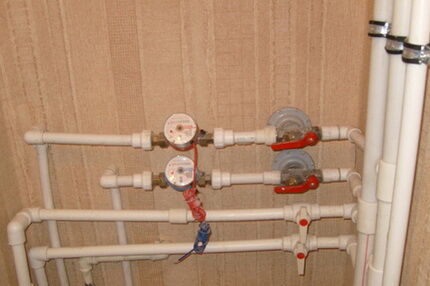
Immediately after the ball valve, it is recommended to install a special leakage protection system equipped with a controlled shut-off valve. After this, a self-cleaning main filter is installed. It will remove coarse impurities from the water, which significantly extends the service life of the devices.
It should be followed by water meters, if they are needed.
Next you can install the water flow regulator. This is not a mandatory element - it is only needed where there are problems with water pressure. Next, serial or collector wiring of open or hidden installation type is performed.
Conclusions and useful video on the topic
Subtleties of arranging pipes in the bathroom:
How to properly perform hidden wiring:
How to properly arrange water supply and sewerage outlets:
It is quite possible for a home craftsman to independently install pipes in a bathroom or a combined bathroom. An inexperienced plumber needs to strictly follow the requirements of the instructions, perform all work competently and efficiently, and choose the right pipes and other elements.
If you have doubts about your own abilities, you should invite an experienced mentor or seek help from a professional plumber.
Do you have experience in installing pipes in the bathroom? Please tell us what laying scheme you followed, share information about the selection and installation of pipes. You can leave comments in the form below.




I don’t really understand why it is said that with a serial type of wiring you cannot turn off one of the devices in the system. At the approach to each device, a branch is still made in the form of a small section of pipe. A shut-off valve is installed there and that’s it.It is necessary - cut off the access of water to the same washing machine and disconnect it for good measure. Or change the toilet. The collector wiring is very cumbersome for an apartment. And in terms of money, it will cost several times more.
And if this shut-off valve leaks, you will have to turn it off completely.
And if the collector leaks, you won’t have to completely shut it off, eh?